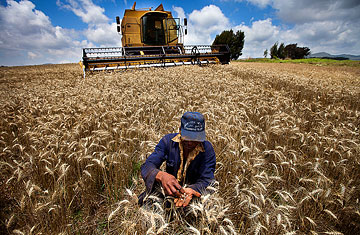
A farm worker inspects wheat ears before harvesting on a large-scale wheat farm in Timau, near Nanyuki, Kenya
(2 of 2)
One way to do that is to focus on the parts of the planet where agricultural yield is lagging. Some of those areas are familiar, like sub-Saharan Africa, where poverty and lack of fertilizer and infrastructure means that the average farmer produces far less corn or grain per acre than the land could produce under ideal conditions. But some other under-performing regions are surprising: Eastern Europe, thanks to the utter mess that was Soviet agricultural policy, lags far behind where it should. "We need to focus agriculture improvement in places with a "yield gap," says Foley. "Then we'll be able to grow more on the same amount of land."
Just how we go about doing that is where matters get sticky. Farmers in regions like the American Midwest can now produce an amazing amount of food per acre — each American farmer produces enough food to feed over 150 people. That's productivity is due largely to what's known as the Green Revolution, the use of irrigation and chemical fertilizers to supercharge farming. But that productivity comes along with serious side effects, from the aquatic dead zones created by fertilizer runoff in coastal farms to the health problems and ecological damage associated with chemical pesticides. Even if we wanted to export the Green Revolution in total to those struggling farming regions, we might not have the water or the cheap energy to do it — not unless we want farming to come at the expense of the environment.
But simply going organic won't solve the problem either. Perhaps 1% of the world's cropland is farmed organically, and as Foley put it in one talk, that food mostly goes to "white people in rich countries with middle class or higher incomes." Foley co-authored a recent paper in Nature that compared agricultural yield for conventional farming to organic practices for a number of different crops, and found that the conventional agriculture produce considerably more food per acre, especially for major grains like rice and wheat. But at the same time Foley notes that genetically modified crops — so often cited as saviors by those in conventional agriculture — have yet to make a real difference in feeding the planet, since nearly all GM crops are currently used to feed animals or for clothing and fiber.
So what do we do then? Foley calls for something he terms "terraculture" — essentially farming done with the planet in mind. That means taking the best of both conventional and organic agriculture, using water far more efficiently for irrigation than we do now and even altering our diets. The last bit isn't about farming, but it could be critical. Much of the grain grown in developed nations goes to feed not human beings but domesticated animals, and inefficiently too — one filet mignon requires 32 lbs. of corn, and converts that grain into calories at just 3% efficiency. Globally we'll likely need to eat less meat — if only to give parts of the growing developing world space to eat a little meat — and, at least in much of the unhealthily overfed West, eat fewer calories overall. That might help reduce global food waste — one out of every three calories produced globally are never eaten, which isn't just a waste of food but of water, land and energy.
Answering the other inconvenient truth is going to require a lot of changes, from the individual consumers up to the massive global companies that produce and sell much of the food we eat. That won't be simple, but as Foley says: "There is no silver bullet solution. But there is silver buckshot." And we'll need it all.
Bryan Walsh is a senior editor at TIME. Find him on Twitter at @bryanrwalsh. You can also continue the discussion on TIME's Facebook page and on Twitter at @TIME
